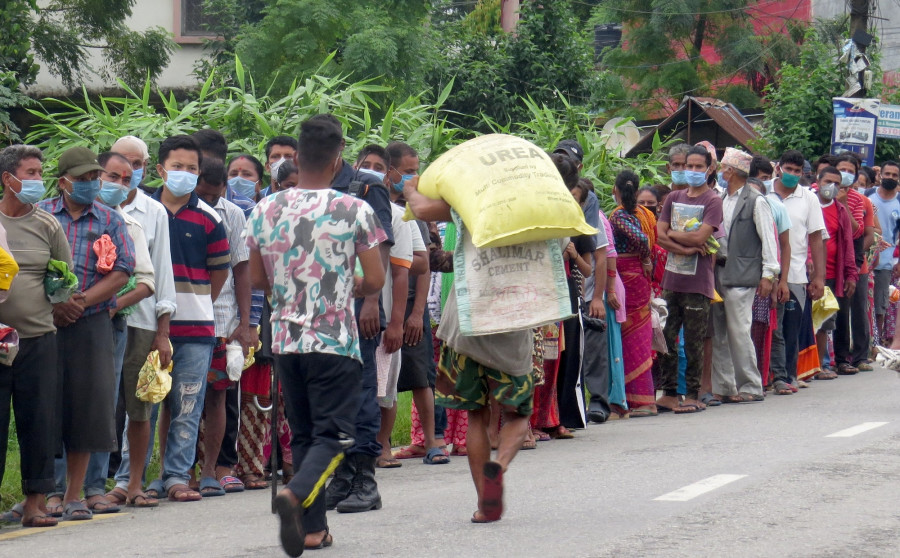Columns
Feeding plants to feed people
News stories of farmers not getting fertiliser on time and annual shortages keep appearing in the media.
Arun GC
The use of fertiliser is as old as farming. Scientists at Oxford University have proven the use of manure by agriculturists in Europe around 8,000 years ago. They found a significantly high level of nitrogen-15 isotope in 7,900-year-old cereals, lentils and peas retrieved from Europe, which is evidence of the use of manure in farming at that time. The use of chemical fertiliser started in the mid-20th century. Modern agriculture waited till the ground-breaking research of Justus von Liebig in the 19th century. He postulated that nitrogen, phosphorus and potassium are the fundamental nutrients for plants. He reported that plants remove these elements from the soil. So, to maintain soil fertility, we need to replenish them.
Nepal started to import chemical fertiliser in the early 1950s. The government established Agriculture Inputs Company in 1966 under the Ministry of Agriculture to import and distribute chemical fertiliser in Nepal. The government introduced subsidies in 1973-74 after seeing that marginal farmers would not be able to afford fertiliser which had become dearer following a hike in global oil prices. Since then, the government has been allocating a significant budget to purchase and distribute subsidised fertilisers. Nonetheless, news stories of farmers not getting fertiliser on time and annual shortages keep appearing in the media.
Opposite results
In the fiscal year 1997-98, following constant pressure from international agencies, the government withdrew fertiliser subsidies and ended the monopoly of Agriculture Inputs Company on the importation and distribution of fertiliser under the banner of liberalisation. But the move produced results that were just the opposite of what had been anticipated. Fertiliser imports and consumption plunged to record lows. Ultimately, in 2008-09, the government reintroduced fertiliser subsidies and took control over fertiliser imports too.
Under the new fertiliser policy, the government assigned Agriculture Inputs Company and Salt Trading Corporation to import and distribute subsidised fertiliser. Initially, cooperatives were the sole retailers of subsidised chemical fertiliser. A recently introduced directive took away the monopoly of cooperatives on retailing fertiliser. According to the World Bank's database, the global use of chemical fertiliser was recorded at 140.5 kg per hectare in 2016. Nepal was placed in the 131st place in fertiliser use at 74 kg per hectare. Our two neighbours India and China use 165.8 and 503.3 kg per hectare respectively.
Under the banner of modernisation and commercialisation, mono-cropping is still being promoted extensively instead of our traditional integrated farming system. The recent advocacy of monoculture is prompted by expectations of higher yield, trouble-free management, potentiality of greater mechanisation and consequently greater profitability. However, we were not able to provide all factors of production on time and at a cheap rate—specifically improved seeds and fertilisers. Furthermore, in comparison with our traditional integrated farming, mono-culture is not a sustainable alternative. We artificially created high demand for chemical fertiliser by abandoning our traditional fertilisation methods—green manuring, intercropping and farmyard manure—but failed to supply substitutes.
We failed to acknowledge soil as an ecosystem. We saw soil as a mechanical source of nutrients, and firmly believed that we could provide those nutrients from synthetic sources. However, continuous application of imbalanced chemicals destroys the soil's native ecosystem. More importantly, nitrogen, phosphorus and potassium are not the only plant nutrients—16 micronutrients have been identified. The most important thing needed for plants to grow is organic matter. None of the chemical fertilisers provides organic matter. The government's 20-year vision document—Agriculture Development Strategy—aims to bring organic matter to 4 percent. But the government has been giving excessive focus to supplying as much urea, DAP and potash as farmers want.
Balanced diet
Like the necessity for a balanced diet for humans, plants also need balanced nutrients. However, under the banner of chemical fertiliser, undue emphasis is being placed on nitrogen, phosphorus and potassium. Interestingly, there is also massive demand from farmers for urea, which has the highest nitrogen content of 46 percent. My coach at a training programme Prof Kevin D Walker once remarked how we disregard the items on our shopping list when we go to a supermarket, and instead buy things that are on offer. In the same way, farmers are asking for urea because the government is offering a huge subsidy on it. Therefore, a rethink of the subsidy proportion is urgent. India has redesigned its subsidies based on nutrients. The government's subsidy policy should promote balanced nutrient use.
Several modern fertilisers have been developed targeting a specific crop for a particular growth stage. Moreover, different forms of fertilisers were developed to enhance the efficiency of fertiliser. Further, fertiliser application has also been revolutionised. Instead of just spreading it over the field, drones are used to apply specific amounts of a particular nutrient at precise coordinates based on commands received from field indicators and satellite data analysed by big data analysis programmes. At this stage, we lack the expertise and means to utilise such advanced technology. But we should make a start in this direction. Application of balanced plant nutrients should be a pre-condition in agriculture—from both sustainability and food security points of view.
***
What do you think?
Dear reader, we’d like to hear from you. We regularly publish letters to the editor on contemporary issues or direct responses to something the Post has recently published. Please send your letters to [email protected] with "Letter to the Editor" in the subject line. Please include your name, location, and a contact address so one of our editors can reach out to you.




 13.12°C Kathmandu
13.12°C Kathmandu















